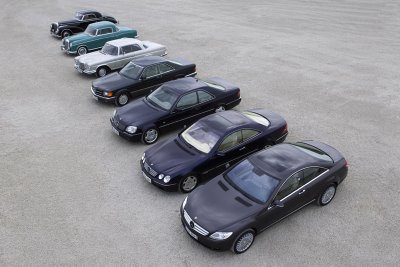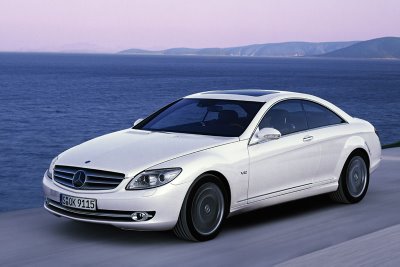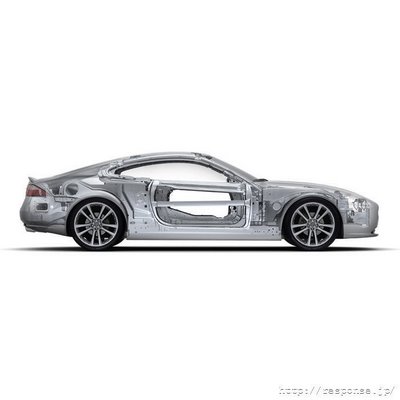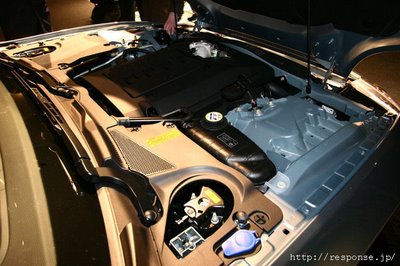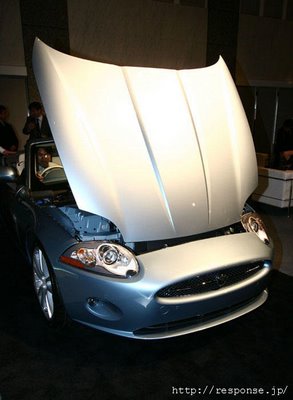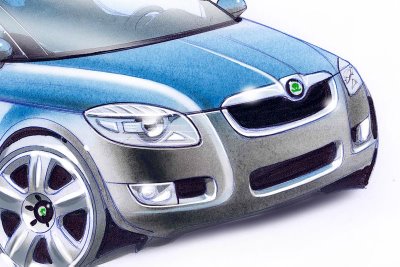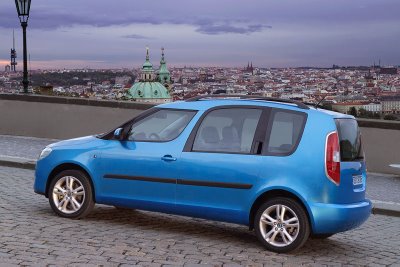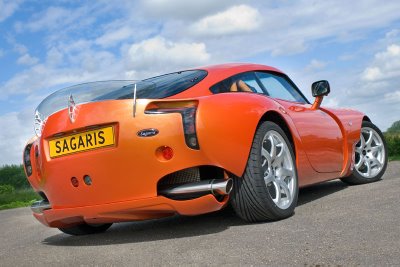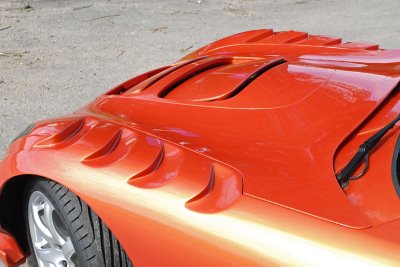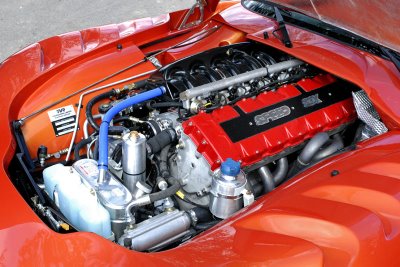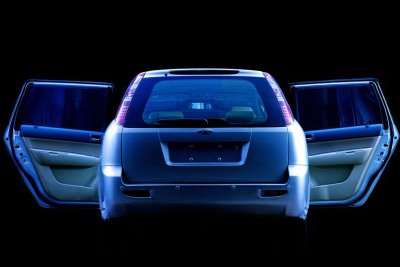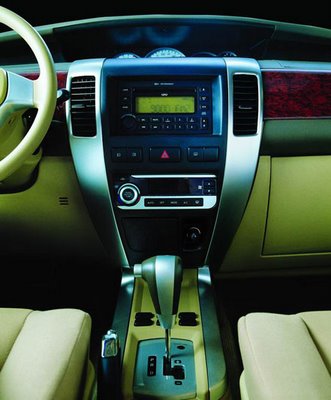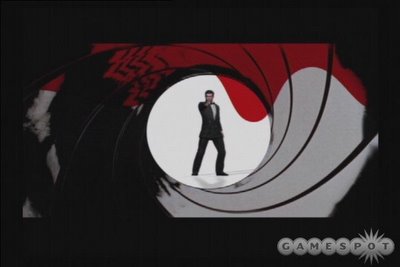Wednesday, June 28, 2006
Monday, June 26, 2006
Tengku Mahaleel speaks up on Agusta issue
Former Proton CEO Tengku Tan Sri Mahaleel Ariff today spoke out in defence of the purchase of MV Agusta, which was carried out when he was CEO of the company, as well as questioned the sale of the Italian motorcycle manufacturer. He explained at a press conference this morning that the purpose of his action was two-fold: firstly, because Proton’s board had decided not to respond to questions earlier posed [concerning the Agusta sale for one euro] by Tun Dr Mahathir, who is Proton’s advisor, and by himself and secondly, to respond to allegations that his decision to purchase Agusta was a bad one which had put Proton at risk.
"By not replying in itself is a transparency of falsehood contrary to the wishes of the Government and transparent for all to see," he said, referring to the issues that had been raised earlier, namely the process of the sale of Agusta, that the sale had been part of its divestment of non-core assets, and that Proton’s current losses are being attributed to losses of Agusta. Tengku Mahaleel said that his statements at the press conference today were also shared by Tun Mahathir who was unable to attend as he was overseas. In continuing to seek answers from Proton, Tengku Mahaleel explained that it was a matter of public interest since Proton is a national company and ‘for the sake of good ethical practices’.
By his calculation, the sale of Agusta for just one euro had lost Proton 69.999 million euros plus fees to consultants and Italian court administrators which added another 6 million euros for a total loss of 75.99 million (RM340 million). “For this money, 11,000 Malaysian fisherman could each have been given a boat,” he said.
The former CEO then went on to provide an insight into Proton’s internal management processes and control systems and questioned if the processes were followed prior to selling off Agusta. He also wanted to know the positions taken by certain board members who had earlier approved the purchase of the Italian company, and why they had seen reasons to sell it off.
Recalling that it took some 14 months to deliberate on the purchase of Agusta, Tengku Mahaleel expressed surprise that selling it off took just two months to decide. According to him, the 14-month period began in December 2002 when Agusta was identified for acquisition. When asked if Tun Dr Mahathir had, at that time, been briefed on the intention to make the acquisition and whether he was positive about it, Tengku Mahaleel said he had been told all the pros and cons and the risks and had been agreeable as well.
Tengku Mahaleel also questioned the declaration by Proton’s board that Agusta was a ‘non-core business’, hence the need to sell it off. In his view, Agusta should not be seen as a mere ‘motorcycle company’ but as an automotive company which has the full scope of activities of any automotive manufacturer. Therefore, in selling off Agusta, he sees it as having sold off a core asset of Proton.
On why he had supported the decision to buy Agusta (and obviously still supports it), he said that it was ‘a strategic acquisition to ensure Proton’s future’ particularly as that future seems uncertain with auto policies that are inconsistent and sometimes not transparent.
“With the changing Malaysian auto policy, Proton’s future cashflows will not be sustainable as its domestic market share falls below 30%. Shocking as it may be, Proton’s Q2 operating profit is a negative (-RM7 million) well before the forecast of 2008 of severe competition,” he said. “So it is even more urgent that it has to find ways of gaining new profits to maintain its level of operations and R&D investment. This means the combination of Lotus and MV Agusta is crucial for Proton.”
He said that the combined income – from 2008 – would be able to fund Proton’s need of RM500 million annually to maintain its level of investments for new products and market expansion and that around half of that had been forecast to be contributed by Lotus and Agusta.
"Of course, this also depends on Proton’s management skills to turn around and introduce new products quickly," he added.
To support his forecast that Agusta could actually become a profit centre for Proton, he revealed the 2006 earnings forecast prepared by Price Waterhouse Coopers, an independent accounting firm, which was said to be a ‘conservative’ one. In the forecast (before tax), Agusta could be making RM73 million this year (best case) and even in the worst case, RM31 million. The forecast for 2010 was RM228 million.
The key technologies which Agusta already has have been presented as one of the important reasons for acquiring it and he again emphasised them with more elaboration than before. Being a motorcycle manufacturer, Agusta has the expertise to make small yet powerful high-tech engines and could develop 850 cc and 1000 cc engines for Proton models at 50% what it would cost Proton/Lotus to develop. Such engines would be RM2,500 cheaper than the engine currently used in the Savvy, and on a production run of 250,000 Savvys over 5 years, it would thus be possible to lower production costs by RM625 million. This figure, he pointed out, more than paid for the 70 million euros which Proton had paid to buy over Agusta.
Tengku Mahaleel also revealed that Agusta had a concept for a RM10,000 car using unique manufacturing methods and also had a patented airflow system which was going to be used for the Campro engines. The Italian company also has a very unique gearbox which would be valuable to Proton.
Returning to the financial issues, he revealed the purchase conditions which were agreed upon when Proton bought over Agusta (or more accurately, acquired the MV Group through a share injection of 70 million euros). The conditions related to the settlement of Agusta’s debts with specific terms over a 4-year period, and he claimed that even prior to purchase, Proton had managed to reduce the debt level to 68 million euros.
Crucial to the survival of Agusta, which was on the brink of bankruptcy, was getting working capital and to address this quickly, it was decided that the unused credit line of 9 million euros available through Proton UK would be utilised. Also, group purchasing of Japanese parts worth 12 million euros was carried out, optimizing buying power.
Having made a case for a turn-around strategy, Tengku Mahaleel said that it made no financial sense to sell off the company for one euro and that ‘the Proton board’s action and intention is difficult to comprehend’. He revealed that the CEO and CFO of Agusta had attempted to discuss the matter with Proton’s board but had difficulty doing so and more puzzling was why the Proton board had chosen to cut off Agusta (financially) when financial advisors had recommended financial support to continue at least for the 2005/2006 annual management plan and then decide what further course of action should be taken.
When asked to comment on the statement by an analyst that Agusta's creditor banks were on the verge of foreclosing and if that had happened, Italian law would have held Proton responsible for all Agusta’s contingent liabilities, he replied: “You can always negotiate [on debt repayment]. The key point on negotiation is whether you are on target. Banks would love to lend money to you when they know you have a backer, but when the backer pulls out, the banks pull out.”
The final part of his presentation aimed to show that Proton’s losses in Q1/Q2 of its financial year (not the calendar year) are not wholly due to Agusta – and also nothing to do with him since he had already departed from Proton. He noted that Proton’s reports of loss during the two quarters were due to provisions of RM137 million and RM161 million, respectively, and drew attention to the fact that the provision for Agusta was only RM45 million in the first quarter. In other words, Proton’s losses could not be blamed entirely on the Agusta issue.
An interesting fact he produced was that unsold stocks at the end of October 2005 were 25,000 units which, if valued at RM40,000 each, amounted to RM900 million. While he said he could not recall what the stock position was at the beginning of 2005, he did say that he had understood that there were at least 30,000 units of unsold stocks now and lamented that 18,000 units of those were 2005 models which would likely have to be sold at a discount since they are old models.
In wrapping up his presentation, he provided an overview of the management performance ‘before and after’ which were very interesting:
GROWTH BETWEEN 1996 ~ 2004
Turnover : from RM5 billion to RM12 billion
Assets: from RM1.7 billion to RM5.6 billion
Cash/equivalents: from RM450 million to RM2.6 billion
Profits: no losses reported
EXPENDITURES (INTERNALLY FUNDED)
Waja development : RM817 million
Gen2 development: RM500 million
SRM development: RM445 million
Savvy development: RM467 million
ACQUISITIONS
USPD (which became Proton Edar) : RM384 million
Proton Commerce: RM125 million
Lotus: RM503 million
MV Agusta: RM364 million
Tg Malim plant project: RM1.8 billion
Given the strategy that he and his team had formulated, which included the anticipated revenues from Lotus and Agusta – from 2008 - Tengku Mahaleel said that Proton would have been able to fully repay its government loan of RM800 million (which was given when Proton began business) by 2007. However, in view of what has taken place since the new management took over, he believes that ‘the sale of Agusta has placed risk on the company’s future, reduced its ability to increase engineering capability and also reduced its access to new markets through the Agusta network and products’.
As a closing statement, he stated that both he and Tun Dr Mahathir wish to register their interest to buy Lotus for one British pound, or more than one pound, if and when it is for sale. Their rationale is that a precedent has been set (through the sale of Agusta for one euro).
Tengku Mahaleel certainly had the right to speak up on the history and process by which the decision was made to acquire Agusta since it was done when he was CEO. Understandably, he is disturbed that public opinion has been influenced by various commentaries that his decision was a bad one, thus putting his performance as CEO in a negative light. However, his situation is no different from that of Carly Fiorina (former CEO of HP), Jurgen Schrempp (former CEO of DaimlerChrysler), Bernd Pischetsrieder (former CEO of BMW) and Jac Nasser (former President of Ford Motor Company), all of whom were forced to depart from their respective companies under controversial circumstances. These CEOs had all been ‘bright stars’ and seemed to do no wrong, were given a free hand to buy up other companies and spent billions to execute what they believed to be sound business plans. Like Tengku Mahaleel, they too defended all they had done as being ‘the best strategy’ for their companies; surely none of them would admit that he or she had made a bad decision?
It is also reasonable to question the motives of Proton’s board in selling off Agusta but then again, seeing that the company’s profits and market share were declining, they had to act and in their mind, Agusta may have been a burden the company could do without. They may have a different perception of the value of Agusta and the route Proton needs to take to survive. Can anyone be so certain that his strategy is The Right One? Only time will tell whose move was the right one because predicting the future with certainty is a skill which humans do not have.
"By not replying in itself is a transparency of falsehood contrary to the wishes of the Government and transparent for all to see," he said, referring to the issues that had been raised earlier, namely the process of the sale of Agusta, that the sale had been part of its divestment of non-core assets, and that Proton’s current losses are being attributed to losses of Agusta. Tengku Mahaleel said that his statements at the press conference today were also shared by Tun Mahathir who was unable to attend as he was overseas. In continuing to seek answers from Proton, Tengku Mahaleel explained that it was a matter of public interest since Proton is a national company and ‘for the sake of good ethical practices’.
By his calculation, the sale of Agusta for just one euro had lost Proton 69.999 million euros plus fees to consultants and Italian court administrators which added another 6 million euros for a total loss of 75.99 million (RM340 million). “For this money, 11,000 Malaysian fisherman could each have been given a boat,” he said.
The former CEO then went on to provide an insight into Proton’s internal management processes and control systems and questioned if the processes were followed prior to selling off Agusta. He also wanted to know the positions taken by certain board members who had earlier approved the purchase of the Italian company, and why they had seen reasons to sell it off.
Recalling that it took some 14 months to deliberate on the purchase of Agusta, Tengku Mahaleel expressed surprise that selling it off took just two months to decide. According to him, the 14-month period began in December 2002 when Agusta was identified for acquisition. When asked if Tun Dr Mahathir had, at that time, been briefed on the intention to make the acquisition and whether he was positive about it, Tengku Mahaleel said he had been told all the pros and cons and the risks and had been agreeable as well.
Tengku Mahaleel also questioned the declaration by Proton’s board that Agusta was a ‘non-core business’, hence the need to sell it off. In his view, Agusta should not be seen as a mere ‘motorcycle company’ but as an automotive company which has the full scope of activities of any automotive manufacturer. Therefore, in selling off Agusta, he sees it as having sold off a core asset of Proton.
On why he had supported the decision to buy Agusta (and obviously still supports it), he said that it was ‘a strategic acquisition to ensure Proton’s future’ particularly as that future seems uncertain with auto policies that are inconsistent and sometimes not transparent.
“With the changing Malaysian auto policy, Proton’s future cashflows will not be sustainable as its domestic market share falls below 30%. Shocking as it may be, Proton’s Q2 operating profit is a negative (-RM7 million) well before the forecast of 2008 of severe competition,” he said. “So it is even more urgent that it has to find ways of gaining new profits to maintain its level of operations and R&D investment. This means the combination of Lotus and MV Agusta is crucial for Proton.”
He said that the combined income – from 2008 – would be able to fund Proton’s need of RM500 million annually to maintain its level of investments for new products and market expansion and that around half of that had been forecast to be contributed by Lotus and Agusta.
"Of course, this also depends on Proton’s management skills to turn around and introduce new products quickly," he added.
To support his forecast that Agusta could actually become a profit centre for Proton, he revealed the 2006 earnings forecast prepared by Price Waterhouse Coopers, an independent accounting firm, which was said to be a ‘conservative’ one. In the forecast (before tax), Agusta could be making RM73 million this year (best case) and even in the worst case, RM31 million. The forecast for 2010 was RM228 million.
The key technologies which Agusta already has have been presented as one of the important reasons for acquiring it and he again emphasised them with more elaboration than before. Being a motorcycle manufacturer, Agusta has the expertise to make small yet powerful high-tech engines and could develop 850 cc and 1000 cc engines for Proton models at 50% what it would cost Proton/Lotus to develop. Such engines would be RM2,500 cheaper than the engine currently used in the Savvy, and on a production run of 250,000 Savvys over 5 years, it would thus be possible to lower production costs by RM625 million. This figure, he pointed out, more than paid for the 70 million euros which Proton had paid to buy over Agusta.
Tengku Mahaleel also revealed that Agusta had a concept for a RM10,000 car using unique manufacturing methods and also had a patented airflow system which was going to be used for the Campro engines. The Italian company also has a very unique gearbox which would be valuable to Proton.
Returning to the financial issues, he revealed the purchase conditions which were agreed upon when Proton bought over Agusta (or more accurately, acquired the MV Group through a share injection of 70 million euros). The conditions related to the settlement of Agusta’s debts with specific terms over a 4-year period, and he claimed that even prior to purchase, Proton had managed to reduce the debt level to 68 million euros.
Crucial to the survival of Agusta, which was on the brink of bankruptcy, was getting working capital and to address this quickly, it was decided that the unused credit line of 9 million euros available through Proton UK would be utilised. Also, group purchasing of Japanese parts worth 12 million euros was carried out, optimizing buying power.
Having made a case for a turn-around strategy, Tengku Mahaleel said that it made no financial sense to sell off the company for one euro and that ‘the Proton board’s action and intention is difficult to comprehend’. He revealed that the CEO and CFO of Agusta had attempted to discuss the matter with Proton’s board but had difficulty doing so and more puzzling was why the Proton board had chosen to cut off Agusta (financially) when financial advisors had recommended financial support to continue at least for the 2005/2006 annual management plan and then decide what further course of action should be taken.
When asked to comment on the statement by an analyst that Agusta's creditor banks were on the verge of foreclosing and if that had happened, Italian law would have held Proton responsible for all Agusta’s contingent liabilities, he replied: “You can always negotiate [on debt repayment]. The key point on negotiation is whether you are on target. Banks would love to lend money to you when they know you have a backer, but when the backer pulls out, the banks pull out.”
The final part of his presentation aimed to show that Proton’s losses in Q1/Q2 of its financial year (not the calendar year) are not wholly due to Agusta – and also nothing to do with him since he had already departed from Proton. He noted that Proton’s reports of loss during the two quarters were due to provisions of RM137 million and RM161 million, respectively, and drew attention to the fact that the provision for Agusta was only RM45 million in the first quarter. In other words, Proton’s losses could not be blamed entirely on the Agusta issue.
An interesting fact he produced was that unsold stocks at the end of October 2005 were 25,000 units which, if valued at RM40,000 each, amounted to RM900 million. While he said he could not recall what the stock position was at the beginning of 2005, he did say that he had understood that there were at least 30,000 units of unsold stocks now and lamented that 18,000 units of those were 2005 models which would likely have to be sold at a discount since they are old models.
In wrapping up his presentation, he provided an overview of the management performance ‘before and after’ which were very interesting:
GROWTH BETWEEN 1996 ~ 2004
Turnover : from RM5 billion to RM12 billion
Assets: from RM1.7 billion to RM5.6 billion
Cash/equivalents: from RM450 million to RM2.6 billion
Profits: no losses reported
EXPENDITURES (INTERNALLY FUNDED)
Waja development : RM817 million
Gen2 development: RM500 million
SRM development: RM445 million
Savvy development: RM467 million
ACQUISITIONS
USPD (which became Proton Edar) : RM384 million
Proton Commerce: RM125 million
Lotus: RM503 million
MV Agusta: RM364 million
Tg Malim plant project: RM1.8 billion
Given the strategy that he and his team had formulated, which included the anticipated revenues from Lotus and Agusta – from 2008 - Tengku Mahaleel said that Proton would have been able to fully repay its government loan of RM800 million (which was given when Proton began business) by 2007. However, in view of what has taken place since the new management took over, he believes that ‘the sale of Agusta has placed risk on the company’s future, reduced its ability to increase engineering capability and also reduced its access to new markets through the Agusta network and products’.
As a closing statement, he stated that both he and Tun Dr Mahathir wish to register their interest to buy Lotus for one British pound, or more than one pound, if and when it is for sale. Their rationale is that a precedent has been set (through the sale of Agusta for one euro).
Tengku Mahaleel certainly had the right to speak up on the history and process by which the decision was made to acquire Agusta since it was done when he was CEO. Understandably, he is disturbed that public opinion has been influenced by various commentaries that his decision was a bad one, thus putting his performance as CEO in a negative light. However, his situation is no different from that of Carly Fiorina (former CEO of HP), Jurgen Schrempp (former CEO of DaimlerChrysler), Bernd Pischetsrieder (former CEO of BMW) and Jac Nasser (former President of Ford Motor Company), all of whom were forced to depart from their respective companies under controversial circumstances. These CEOs had all been ‘bright stars’ and seemed to do no wrong, were given a free hand to buy up other companies and spent billions to execute what they believed to be sound business plans. Like Tengku Mahaleel, they too defended all they had done as being ‘the best strategy’ for their companies; surely none of them would admit that he or she had made a bad decision?
It is also reasonable to question the motives of Proton’s board in selling off Agusta but then again, seeing that the company’s profits and market share were declining, they had to act and in their mind, Agusta may have been a burden the company could do without. They may have a different perception of the value of Agusta and the route Proton needs to take to survive. Can anyone be so certain that his strategy is The Right One? Only time will tell whose move was the right one because predicting the future with certainty is a skill which humans do not have.
Saturday, June 17, 2006
Sporty two-door Satria Neo unveiled
KUALA LUMPUR: Proton Holdings Bhd has unveiled the highly anticipated Satria Neo, which cost the national car manufacturer RM500 million and about four years to develop.
Proton expects the sporty two-door Satria Neo, the replacement of the popular Satria, to generate a monthly sales volume of 2,000 to 2,500 units.
It is designed for the global market by Proton together with its British engineering subsidiary Lotus.
Managing director Syed Zainal Abidin Syed Mohamed Tahir said Satria Neo should be heading for overseas markets such as the United Kingdom and Australia as early as the third quarter of the year.
"We are looking at the right-hand drive market overseas in the third quarter of this year and the left-hand market in the first quarter of next year," Syed Zainal Abidin said during the media test drive of the Neo in Sepang on Wednesday.
"Regionally, Thailand and Indonesia will also be a market for Satria Neo. We have sent the car to these two countries to gauge the acceptance there," he added.
Satria Neo was launched by Prime Minister Datuk Seri Abdullah Ahmad Badawi, who also launched Proton’s largest and most innovative showroom and service centre called Centre of Excellence, in Subang Jaya yesterday.
Satria Neo, which comes in two engine capacities of 1.3-litre and 1.6-litre and five colours, is priced from RM43,500 to RM54,800 on the road without insurance and road tax.
"Conceptualised on a new platform, Satria Neo exudes energy and style which reflect the lifestyles and desires of our target market," Syed Zainal Abidin said, pointing out that the car was targeted at buyers aged from 18 to 30.
He is hopeful that the Satria Neo would take Proton to a new heights, and improve its image as well as profitability and market share, which has been declining of late as Perodua and non-national makes like Toyota and Honda recorded more sales.
"We know that customers have been waiting for the new model and they will not be disappointed. Our sales target of 2,000 to 2,500 units a month is quite fair as we are mindful of the weak overall market at the moment.
"There are cult followers of the Satria, and we hope the Satria Neo will ride on the success of the predecessor."
He ruled out that the Satria Neo would cannibalise Proton Gen 2 and Savvy, saying that the former was a niche product targeting those who are "youthful and sporty".
Proton Centre of Excellence is located on a 4ha site in UEP Subang Jaya, offering a service centre, Proton i-care, after-sales support, exclusive Proton membership, training centre and Proton Lifestyle boutique.
Proton expects the sporty two-door Satria Neo, the replacement of the popular Satria, to generate a monthly sales volume of 2,000 to 2,500 units.
It is designed for the global market by Proton together with its British engineering subsidiary Lotus.
Managing director Syed Zainal Abidin Syed Mohamed Tahir said Satria Neo should be heading for overseas markets such as the United Kingdom and Australia as early as the third quarter of the year.
"We are looking at the right-hand drive market overseas in the third quarter of this year and the left-hand market in the first quarter of next year," Syed Zainal Abidin said during the media test drive of the Neo in Sepang on Wednesday.
"Regionally, Thailand and Indonesia will also be a market for Satria Neo. We have sent the car to these two countries to gauge the acceptance there," he added.
Satria Neo was launched by Prime Minister Datuk Seri Abdullah Ahmad Badawi, who also launched Proton’s largest and most innovative showroom and service centre called Centre of Excellence, in Subang Jaya yesterday.
Satria Neo, which comes in two engine capacities of 1.3-litre and 1.6-litre and five colours, is priced from RM43,500 to RM54,800 on the road without insurance and road tax.
"Conceptualised on a new platform, Satria Neo exudes energy and style which reflect the lifestyles and desires of our target market," Syed Zainal Abidin said, pointing out that the car was targeted at buyers aged from 18 to 30.
He is hopeful that the Satria Neo would take Proton to a new heights, and improve its image as well as profitability and market share, which has been declining of late as Perodua and non-national makes like Toyota and Honda recorded more sales.
"We know that customers have been waiting for the new model and they will not be disappointed. Our sales target of 2,000 to 2,500 units a month is quite fair as we are mindful of the weak overall market at the moment.
"There are cult followers of the Satria, and we hope the Satria Neo will ride on the success of the predecessor."
He ruled out that the Satria Neo would cannibalise Proton Gen 2 and Savvy, saying that the former was a niche product targeting those who are "youthful and sporty".
Proton Centre of Excellence is located on a 4ha site in UEP Subang Jaya, offering a service centre, Proton i-care, after-sales support, exclusive Proton membership, training centre and Proton Lifestyle boutique.
Proton Satria Neo arrives
PROTON Holdings Bhd has launched the all-new Satria Neo three-door hatchback, which replaces the popular Satria model which was introduced 12 years ago.
Roughly the same size with the original Satria, the Satria Neo is based on an all-new platform with some components derived from the Proton Gen.2 hatchback.
Although the Satria Neo bears the familiar silhouette of the Satria, its bold wheel arches and rounded rear section give it a more aggressive appearance with some styling cues carried over from Proton's Gen 2.
The car is available in 1.3- and 1.6-litre Campro 16-valve double overhead camshaft engines with either a four-speed automatic or five-speed manual gearboxes.
On-the-road price with insurance for the 1.3-litre Satria Neo with manual transmission (MT) is RM43,500, while the 1.3-litre with automatic transmission (AT) is RM46,500.
The 1.6-litre M-Line with MT costs RM48,500, 1.6-litre M-Line with AT (RM51,500), the 1.6-litre H-Line with MT (RM51,800) and the 1.6-litre H-Line with AT (RM54,800).
The Satria Neo is built with a combination of ultra-high and high tensile strength steel, making its body twice as stiff compared with the older Satria.
Its doors are also made from high tensile steel with double impact trapezoid bars for better protection during side impact.
Its suspension system has been tuned by Lotus which promises good handling without sacrificing ride comfort.
The front set-up uses the McPherson struts system with a new cross member designed for high rigidity, while the rear suspension is an improved four-link system with recalibrated shock absorber dampening and spring rates.
All variants come with front and rear disc brakes for better stopping power.
The 1.6-litre standard version comes with rear wiper and roof spoiler, radio with CD player and MP3 capability, steering wheel mounted audio controls, immobiliser, vehicle tracking system and reverse sensor.
The 1.3-litre Satria Neo is equipped with 15-inch tyres on steel wheels, while the 1.6-litre variant comes with 16-inch tyres in alloy sports wheels.
Meanwhile, the 1.6-litre H-Line variant has additional features such as dual front airbags, anti-lock braking system with electronic brakeforce distribution and front seat belts with pretensioners.
Proton Holdings managing director Syed Zainal Abidin Syed Mohamed Tahir said at a media preview of the car in the Sepang International Circuit that the national car company had invested more than RM500mil into the Satria Neo project.
The company is looking at monthly sales of between 2,000 and 2,500 units of the Satria Neo.
Plans are already underway for the Satria Neo to be exported in the third quarter of the year to countries with right hand-drive system such as to Britain, Australia, Indonesia and Thailand.
The left hand-drive version is expected to be ready early next year.
The Satria Neo is available in metal grey, twilight blue, iridescent white, brilliant red and liquid orange.
More photos:
http://www.pro-hatch.net/
Roughly the same size with the original Satria, the Satria Neo is based on an all-new platform with some components derived from the Proton Gen.2 hatchback.
Although the Satria Neo bears the familiar silhouette of the Satria, its bold wheel arches and rounded rear section give it a more aggressive appearance with some styling cues carried over from Proton's Gen 2.
The car is available in 1.3- and 1.6-litre Campro 16-valve double overhead camshaft engines with either a four-speed automatic or five-speed manual gearboxes.
On-the-road price with insurance for the 1.3-litre Satria Neo with manual transmission (MT) is RM43,500, while the 1.3-litre with automatic transmission (AT) is RM46,500.
The 1.6-litre M-Line with MT costs RM48,500, 1.6-litre M-Line with AT (RM51,500), the 1.6-litre H-Line with MT (RM51,800) and the 1.6-litre H-Line with AT (RM54,800).
The Satria Neo is built with a combination of ultra-high and high tensile strength steel, making its body twice as stiff compared with the older Satria.
Its doors are also made from high tensile steel with double impact trapezoid bars for better protection during side impact.
Its suspension system has been tuned by Lotus which promises good handling without sacrificing ride comfort.
The front set-up uses the McPherson struts system with a new cross member designed for high rigidity, while the rear suspension is an improved four-link system with recalibrated shock absorber dampening and spring rates.
All variants come with front and rear disc brakes for better stopping power.
The 1.6-litre standard version comes with rear wiper and roof spoiler, radio with CD player and MP3 capability, steering wheel mounted audio controls, immobiliser, vehicle tracking system and reverse sensor.
The 1.3-litre Satria Neo is equipped with 15-inch tyres on steel wheels, while the 1.6-litre variant comes with 16-inch tyres in alloy sports wheels.
Meanwhile, the 1.6-litre H-Line variant has additional features such as dual front airbags, anti-lock braking system with electronic brakeforce distribution and front seat belts with pretensioners.
Proton Holdings managing director Syed Zainal Abidin Syed Mohamed Tahir said at a media preview of the car in the Sepang International Circuit that the national car company had invested more than RM500mil into the Satria Neo project.
The company is looking at monthly sales of between 2,000 and 2,500 units of the Satria Neo.
Plans are already underway for the Satria Neo to be exported in the third quarter of the year to countries with right hand-drive system such as to Britain, Australia, Indonesia and Thailand.
The left hand-drive version is expected to be ready early next year.
The Satria Neo is available in metal grey, twilight blue, iridescent white, brilliant red and liquid orange.
More photos:
http://www.pro-hatch.net/
Success is your only choice, Abdullah tells Proton
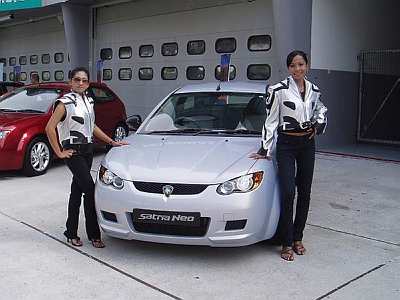
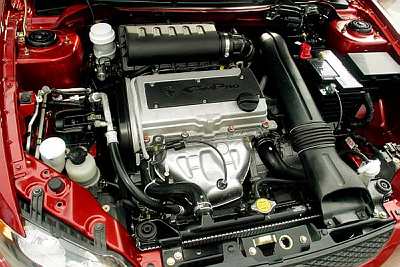
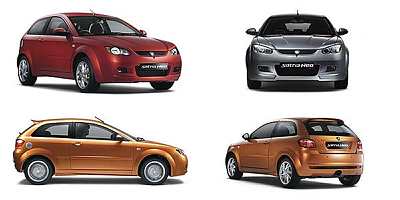
Success is your only choice, Abdullah tells Proton
PETALING JAYA: Failure is not an option for national car company Proton Holdings Bhd, Prime Minister Datuk Seri Abdullah Ahmad Badawi said.
“There is only one choice for Proton ... that choice is to succeed; success is your only choice, failure is not an option,” he said at the launch of the new Satria Neo model at the Proton Centre of Excellence here.
Abdullah said this should always be remembered because Proton was the country’s most prominent automotive company.
Abdullah said Proton was expected to be able to overcome various challenges in the increasingly competitive global automotive industry.
“Proton has to prove its spirit, excellence and capability to produce quality cars for both the domestic and foreign markets,” he said.
He also said that to make Proton more competitive, all the necessary steps should be taken to ensure that the cars produced are of high standard and quality, and available at reasonable prices.In related news, Proton said itexpected to sell a modest 2,000 to 2,500 units of the Satria Neo per month as the new model was tailored for a niche segment of the market.
“This is a long-awaited car. We hope the car will put more excitement in the market and hopefully change the image of Proton,” managing director Syed Zainal Abidin Syed Mohamed Tahir told the media preview on Wednesday.
The Satria Neo is the replacement model for the Proton Satria.
Among the upgrades are better soundproofing and a stronger shell.
The Satria Neo, which is sold in six variants with engine capacities of 1.3 and 1.6 litres, is priced between RM43,500 and RM54,800 (including insurance in peninsular Malaysia), depending on specifications.
On Agusta and Mahaleel
Proton's reply to issues raised by Tun Dr Mahathir Mohamad
On MV Agusta Motors SpA
The disposal did not have any adverse impact on the financial standing of the group. The losses were in fact recognised at the time of purchase.
The entire purchase consideration of RM367.6mil was treated as goodwill and written off immediately in the financial year ended March 31, 2005.
The additional provisions relating to Agusta in the accounts of Proton Group for financial year ended March 31, 2006 amounted to RM136.2mil. This did not have anything to do with the disposal but was related to the loans and advances extended to Agusta by the management.
The disposal avoided the need for additional financial support from Proton group, preventing a further deterioration of its financial standing.
The objectives of acquiring Agusta were not met and would not have been able to without significant investment by Proton.
Proton also refuted the six justifications given for the purchase of Agusta by the previous management saying:
IT WAS unlikely to diversify the revenue stream and reduce reliance on the increasing competitive local car market given the track record of losses over the last six years at approximately Euro20mil (RM92mil) per year;
THE purchase did not assist Proton achieve operational, engineering and technological synergies, as independently confirmed, as Proton manufactures cars for the masses while Agusta manufactures motorcycles;
THE acquisition may have enabled Proton to add a motorcycle brand to its stable but as Proton was automotive related, it would not have a positive impact on the core Proton brand;
PROTON did not have any motorcycle manufacturing programme. As such, the purchase would not accelerate proton's motorcycle programme;
AGUSTA was in the motorcycle industry, not motorcars. And so the argument that Proton would gain access to Agusta's high quality supply chain was irrelevant; and
AGUSTA did not have any technology and styling pedigree in the automotive sector. So it would not be able to enhance Proton's technology and styling capabilities.
An international investment bank appointed to advise on Proton's process of re-evaluating its Agusta investments concluded that:
(1) Agusta's existing business model was neither operational nor financially sustainable.
(2) Developing Agusta into an operating cashflow positive business would require substantial backing from Proton, over an extended period and involve considerable financial risk.
(3) Integration of Agusta's operation with those of Proton was unlikely to deliver significant economies of scale or synergies to the combined business.
(4) There was very real possibility that Agusta would fall into bankruptcy, with significant commercial, financial and reputation risk to Proton.
In the event Agusta goes bankrupt, Proton would have been subjected to a further contingent liability for an amount of up to Euro202 mil (RM923.1mil; at the rate of Euro1 =RM4.57)
After due consideration of the professional advice, given the limited options available, it was clear that the optimal route for Proton was to exit Agusta completely via a disposal of its equity interest.
Not many wanted to buy Agusta due to its huge debt burden and contingent liability and in the circumstances Proton would have to pay people to buy Agusta.
The shares were said to be worthless and it was extremely difficult to sell Agusta. Proton was subsequently approached by Gevi SpA, which was related to an Italian bank.
On Tengku Mahaleel's contract
Mohamed Azlan said the move was well within the ambit and authority of the company and board of directors. Proton is a national asset, an institution of sorts and not a private entity.
Proton reflected the aspirations of a nation in its drive towards industrialisation. Hence, the board had to be proactive to ensure Proton was properly managed and prepared to face the challenges ahead.
The board recognised the immense challenges facing the industry and had expressed its commitment that it would spare no efforts to prompt
and enable Proton to continuously strengthen and improve itself.
Thus, the management changes announced were not about individuals. It was about progressing Proton to face the changing realities of the ever-changing and dynamic automotive industry.
Management renewals at corporate enterprises are a normal occurrence. Proton is not a family company.
The staff and the automotive industry had accepted the change.
On criticisms on the non-renewal, Mohamed Azlan said any changes made, even for the better, would be accompanied by a drawback and taken with reluctance by certain parties.
He said Proton was not trying to blame Tengku Mahaleel for buying Agusta but was merely laying down the facts.
“Basically you came to that conclusion yourself. Those are facts for you to see for yourself,” he said.
On Dr Mahathir
Mohamed Azlan said Proton had made many attempts to meet with Dr Mahathir but the former prime minister was always unavailable.
“A meeting requires two consenting parties. He is very busy but he will give us a time when he is ready,” he said.
He added that Proton would continue to seek his advice.
“It never crossed our minds to replace or remove him. He is our adviser and remains so,” he said.
On Dr Mahathir not attending the launch of the new Proton model yesterday, he said the invitation to him was on short notice and he had informed them that he could not make it.
Related Stories:
Success is your only choice, Abdullah tells Proton
On MV Agusta Motors SpA
The disposal did not have any adverse impact on the financial standing of the group. The losses were in fact recognised at the time of purchase.
The entire purchase consideration of RM367.6mil was treated as goodwill and written off immediately in the financial year ended March 31, 2005.
The additional provisions relating to Agusta in the accounts of Proton Group for financial year ended March 31, 2006 amounted to RM136.2mil. This did not have anything to do with the disposal but was related to the loans and advances extended to Agusta by the management.
The disposal avoided the need for additional financial support from Proton group, preventing a further deterioration of its financial standing.
The objectives of acquiring Agusta were not met and would not have been able to without significant investment by Proton.
Proton also refuted the six justifications given for the purchase of Agusta by the previous management saying:
IT WAS unlikely to diversify the revenue stream and reduce reliance on the increasing competitive local car market given the track record of losses over the last six years at approximately Euro20mil (RM92mil) per year;
THE purchase did not assist Proton achieve operational, engineering and technological synergies, as independently confirmed, as Proton manufactures cars for the masses while Agusta manufactures motorcycles;
THE acquisition may have enabled Proton to add a motorcycle brand to its stable but as Proton was automotive related, it would not have a positive impact on the core Proton brand;
PROTON did not have any motorcycle manufacturing programme. As such, the purchase would not accelerate proton's motorcycle programme;
AGUSTA was in the motorcycle industry, not motorcars. And so the argument that Proton would gain access to Agusta's high quality supply chain was irrelevant; and
AGUSTA did not have any technology and styling pedigree in the automotive sector. So it would not be able to enhance Proton's technology and styling capabilities.
An international investment bank appointed to advise on Proton's process of re-evaluating its Agusta investments concluded that:
(1) Agusta's existing business model was neither operational nor financially sustainable.
(2) Developing Agusta into an operating cashflow positive business would require substantial backing from Proton, over an extended period and involve considerable financial risk.
(3) Integration of Agusta's operation with those of Proton was unlikely to deliver significant economies of scale or synergies to the combined business.
(4) There was very real possibility that Agusta would fall into bankruptcy, with significant commercial, financial and reputation risk to Proton.
In the event Agusta goes bankrupt, Proton would have been subjected to a further contingent liability for an amount of up to Euro202 mil (RM923.1mil; at the rate of Euro1 =RM4.57)
After due consideration of the professional advice, given the limited options available, it was clear that the optimal route for Proton was to exit Agusta completely via a disposal of its equity interest.
Not many wanted to buy Agusta due to its huge debt burden and contingent liability and in the circumstances Proton would have to pay people to buy Agusta.
The shares were said to be worthless and it was extremely difficult to sell Agusta. Proton was subsequently approached by Gevi SpA, which was related to an Italian bank.
On Tengku Mahaleel's contract
Mohamed Azlan said the move was well within the ambit and authority of the company and board of directors. Proton is a national asset, an institution of sorts and not a private entity.
Proton reflected the aspirations of a nation in its drive towards industrialisation. Hence, the board had to be proactive to ensure Proton was properly managed and prepared to face the challenges ahead.
The board recognised the immense challenges facing the industry and had expressed its commitment that it would spare no efforts to prompt
and enable Proton to continuously strengthen and improve itself.
Thus, the management changes announced were not about individuals. It was about progressing Proton to face the changing realities of the ever-changing and dynamic automotive industry.
Management renewals at corporate enterprises are a normal occurrence. Proton is not a family company.
The staff and the automotive industry had accepted the change.
On criticisms on the non-renewal, Mohamed Azlan said any changes made, even for the better, would be accompanied by a drawback and taken with reluctance by certain parties.
He said Proton was not trying to blame Tengku Mahaleel for buying Agusta but was merely laying down the facts.
“Basically you came to that conclusion yourself. Those are facts for you to see for yourself,” he said.
On Dr Mahathir
Mohamed Azlan said Proton had made many attempts to meet with Dr Mahathir but the former prime minister was always unavailable.
“A meeting requires two consenting parties. He is very busy but he will give us a time when he is ready,” he said.
He added that Proton would continue to seek his advice.
“It never crossed our minds to replace or remove him. He is our adviser and remains so,” he said.
On Dr Mahathir not attending the launch of the new Proton model yesterday, he said the invitation to him was on short notice and he had informed them that he could not make it.
Related Stories:
Success is your only choice, Abdullah tells Proton
Wednesday, June 14, 2006
Proton set to unveil new Satria replacement on June 16
Proton Holdings Bhd is set to unveil a new model to replace the two-door compact car, Satria, on June 16 - its first new launch since a year ago, sources said.
The new model is expected to help shore up its market share.
A source working closely on the project said the Satria replacement model (SRM) was named Neon, which will have a Campro engine with capacity of 1.3 litre and 1.6 litre.
The SRM project has been on the radar screen of auto enthusiasts for close to two years.
However, Proton has delayed its launch date for almost a year, despite earlier talk that it was to unveil the model shortly after the Savvy was introduced in June last year.
Proton has been under intense scrutiny and facing fierce competition from local and foreign marques that have been whetting the appetite of car buyers with various launches of new models.
The latest models parked in showrooms are the local version of the Peugeot 206 called Naza Bestari, Naza Sutera and Toyota Yaris, all launched within the last month.
Proton has been criticised for being slow in coming up with new models. As a result, its market share is declining and benefited competitors, especially Perodua with MyVi’s waiting list a few months long.
Proton’s market share fell to 30% in April. Just a year ago, it commanded in excess of 40%, while four years ago, for every two cars on the Malaysian road, one is a Proton.
The new model is expected to help shore up its market share.
A source working closely on the project said the Satria replacement model (SRM) was named Neon, which will have a Campro engine with capacity of 1.3 litre and 1.6 litre.
The SRM project has been on the radar screen of auto enthusiasts for close to two years.
However, Proton has delayed its launch date for almost a year, despite earlier talk that it was to unveil the model shortly after the Savvy was introduced in June last year.
Proton has been under intense scrutiny and facing fierce competition from local and foreign marques that have been whetting the appetite of car buyers with various launches of new models.
The latest models parked in showrooms are the local version of the Peugeot 206 called Naza Bestari, Naza Sutera and Toyota Yaris, all launched within the last month.
Proton has been criticised for being slow in coming up with new models. As a result, its market share is declining and benefited competitors, especially Perodua with MyVi’s waiting list a few months long.
Proton’s market share fell to 30% in April. Just a year ago, it commanded in excess of 40%, while four years ago, for every two cars on the Malaysian road, one is a Proton.
Monday, June 12, 2006
Friday, June 02, 2006






